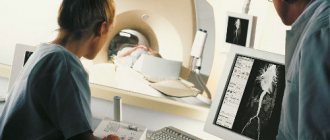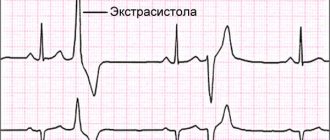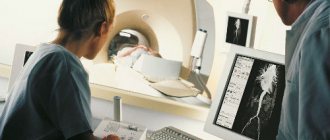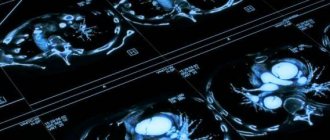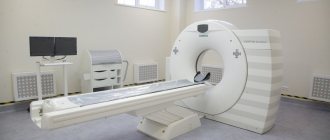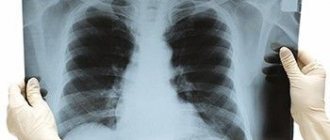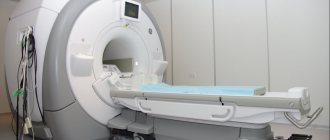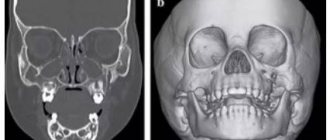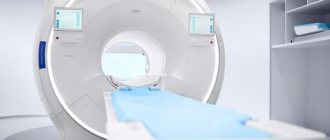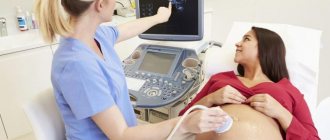Exercise electrocardiography (ECG) is a diagnostic test that shows how well your child's heart works during activity and how it adapts to different levels of exercise. If an exercise bike is used as a load, then electrocardiography with load is often called bicycle ergometry. A treadmill can also be used to create physical stress on the child’s body. This diagnostic procedure is performed for children who can walk or run on a treadmill or pedal an exercise bike and are mature enough to understand what is being asked. Typically, a stress ECG is performed on children aged 5 years and older.
Physical basis of electrocardiographic study with stress.
During operation, the electrical activity of the heart constantly and rhythmically changes in accordance with the stages of compression or relaxation (systole and diastole). An electrocardiograph records the difference in electrical potentials between two areas of the heart's projection onto the surface of the child's body and displays the results in the form of a characteristic graph - a cardiogram on a strip of paper or a computer screen. The number of waves per minute on the graph shows the heart rate, the distances between identical elements of the cardiogram - heart rate. Waveforms show how the heart's electrical impulses are formed and how well the individual parts of the heart work together. Based on the shape and size of the elements of the cardiogram, the doctor can judge the quality of the child’s heart and determine signs of possible diseases.
During exercise, the body needs additional oxygen. The heart and lungs must work harder than usual to supply the body with extra oxygen. When performing physical exercises, the heart begins to work harder: it contracts more often and stronger in order to increase the output of pumped blood and maintain blood supply to the muscles and other involved organs at a level adequate to the load. At the same time, the heart muscle itself begins to consume more oxygen supplied with the blood through the cardiac blood vessels.
Electrical activity from the surface of the body is recorded through small metal plates (electrodes) that are placed in specific places on the child's chest, arms and legs. The electrodes are connected to the cardiograph by wires through which information is recorded. During exercise, the electrocardiograph will record changes in heart rate, heart rate, blood pressure, and other symptoms as your child exercises—at first at a slow pace, then faster and faster until he reaches the highest level. All obtained electrocardiogram data will be measured, analyzed by a computer and a doctor, who will form a conclusion based on the results of the study.
Positive test
Criteria for a positive test: the appearance of a typical anginal attack, the development of rhythm or conduction disturbances during the test (atrial fibrillation, atrioventricular block, frequent extrasystoles, etc., ST segment depression of more than 2 mm during the test, inversion of the T wave into the negative phase). If the test is positive, the heart rate at which the indicated signs appeared, the double product, the maximum load power or the MET value should be noted when the criteria for stopping the test appear.
Based on the results of the test with physical activity, a conclusion is issued: a) positive test, b) negative test, c) doubtful or d) unreliable (incomplete, uninformative) test.
Preparing for the study
Stress ECGs are usually performed in the morning when your child is well rested and energized. Your child should eat a light breakfast and drink clean water at least 2 hours before coming for the test. 12 hours before the test it is forbidden to drink coffee, tea and energy drinks. It is necessary to take with you sportswear for the season and sneakers, a towel and a change of clothes for changing into dry clothes after the examination. If a child uses an inhaler for breathing, you must take it with you. If you are monitoring your child's blood glucose levels, bring a glucometer with you to monitor before and after the test. If your glucose level is low before the test, tell your doctor immediately. Medicines to control blood glucose (“sugar”) levels can only be taken after the procedure is completed.
If your child is taking heart medications, check in advance with your attending physician and the doctor who will conduct the stress ECG which of them can be taken and how they can be taken on the day of the test. Your doctor may recommend that you stop taking medications such as cardiac glycosides, diuretics, calcium antagonists, and long-acting nitrates in advance.
Children tend to be less afraid and feel more confident during exploration when they know what to expect. Tell your child in advance how the test will work, focusing on what your child will see, hear, and feel. Tell your child that the study will not harm his health, and answer all his questions in detail.
Negative test
A conclusion about a negative test is formed in the absence of clinical and ECG signs of coronary circulatory disorders. In this case, attention should be paid to the patient achieving a submaximal heart rate (75–85% of the maximum heart rate for his age) and performing a load of at least 150 watts (12 MET). For example, achieving a heart rate of 150 min-1 at a load of 125 W does not allow us to conclude that the test is negative, since the submaximal heart rate was achieved at a load of less than 150 W. If, with a load of 150 W, a heart rate of 130 min-1 is achieved, which is less than 75% of the maximum heart rate, the test should still be regarded as negative. Our own experience and data from the medical literature suggest that patients with coronary artery disease are not able to perform a load of 150 watts with a heart rate less than submaximal.
How is the research going?
Exercise electrocardiography is performed in a separate room where an electrocardiograph and a simulator are installed. Electrodes (small plastic patches with metal strips) will be attached to your baby's chest, and one electrode will be attached to each arm and leg. The electrodes will be connected to the electrocardiograph by wires. A blood pressure cuff will be placed on your child's arm. When blood pressure is measured during the study, the cuff will be inflated with air and will tightly squeeze the child's arm. During the ECG recording, the child will not feel anything unpleasant. No current will be passed through the electrodes - they are simply sensors for obtaining information.
First, a cardiogram is recorded at rest (without load), and then the child is asked to begin performing physical exercise at a certain rhythm, during which an ECG is also recorded. Finally, your child will be asked to perform the exercise with maximum effort. When your child becomes tired or has abnormal ECG changes or a significant increase in blood pressure, the test will be stopped.
Attention! The child should know that the doctor should be immediately informed if pain or discomfort in the chest, heart area, arm, jaw, dizziness or other unusual sensations occurs during the examination.
After performing weight-bearing exercises, a resting ECG will be recorded again to see how quickly the child's cardiovascular parameters return to normal levels.
Because the child will be performing the exercise at a high level of physical activity, some shortness of breath and muscle fatigue should be expected, which is a normal physiological reaction. The doctor will monitor your child closely throughout the procedure to make sure that the child and his heart are able to handle the increased workload. The most important thing parents can do is to encourage their child to exercise to the highest level of ability, explaining to the child that exercise is not harmful or painful.
The duration of physical activity usually does not exceed 15 minutes, and the entire study takes about 45 minutes.
Diagnostic stress test
In patients with cardialgia, to verify the diagnosis of coronary artery disease, an exercise test is performed on a bicycle ergometer or on a treadmill. The choice of research technique depends on the technical capabilities of the laboratory, on preferences and, to a lesser extent, on the physical condition of the patient.
Some patients find it easier to perform the exercise on a bicycle ergometer, while others find it more convenient to use a treadmill. People with excess body weight (more than 100–110 kg) are offered a treadmill, as are patients with concomitant pathology of the lower extremities (joint diseases, vascular pathology), who find it difficult to perform exercises on a bicycle ergometer.
It is preferable for women to be prescribed a treadmill; all other things being equal, they perform a higher power load on the treadmill, and accordingly, a higher heart rate is achieved. When performing a test on a bicycle ergometer, women and older patients stop the load before reaching a submaximal heart rate for noncardiac reasons (fatigue, pain in the legs, etc.), accordingly, the test is incomplete and diagnostically insignificant.
A diagnostic exercise test is prescribed to patients with an initially unchanged ECG, on which the ST segment is located on the isoline. This is primarily due to the fact that a positive stress test in the classic case presupposes ST segment depression of more than 1 mm (0.1 mV) or its elevation of more than 2 mm (0.2 mV).
Beta blockers and coronary lytics, as well as vasodilating drugs, are discontinued 1–2 days before the study. If for clinical reasons it is impossible to stop taking these drugs (retrosternal pain due to drug withdrawal), interpretation of the study results will be extremely difficult, and the test itself will be devoid of diagnostic meaning.
Contraindications to performing an ECG with stress
Since the load on the child’s heart increases during the study, there are a number of absolute contraindications for the procedure. They are rare in children, but, nevertheless, it is necessary to know about them:
- acute myocardial infarction (within 48 hours)
- unstable form of angina, uncontrolled heart rhythm disturbances,
- acute endocarditis
- myocarditis or pericarditis
- severe aortic stenosis
- decompensated heart failure
- acute pulmonary embolism or pulmonary infarction
- deep vein thrombosis
The study is also contraindicated in case of infectious diseases, renal failure, and thyrotoxicosis. Caution should be exercised when performing an ECG with stress in cases of hypertrophic cardiomyopathy, coronary artery stenosis, tachyaartymia or bradyarrhythmia, hypertension, hyperthyroidism, stroke (less than 1 month), and disorders of the conduction system of the heart.
Decoding the results
The results of the study contain a conclusion about the presence or absence of signs of impaired blood supply to the heart muscle during physical activity, the response to the load of blood pressure levels and the rate of recovery of initial indicators after exercise. Based on the research, recommendations can be made about the acceptable level of physical activity for your child. In some cases, a repeat electrocardiographic study or a special type of ECG may be required, accompanied by other types of studies (ultrasound of the heart, Doppler sonography of blood vessels).
Stress electrocardiography is a special type of study of the characteristics of a child’s heart during physical activity, which allows you to identify hidden diseases, accurately establish a diagnosis and carry out the required treatment with maximum efficiency, or get rid of worries and doubts about the state of your baby’s health.
For additional information about stress electrocardiography for a child, you can sign up for diagnostics at a medical clinic by calling +7 (812) 331-24-22.
ECG in the multidisciplinary clinic "MedicCity"
Having an electrocardiogram in our clinic means taking care of your health, as well as saving money, time and nerves!
Without queues, at a convenient time, in a matter of minutes you will receive an objective diagnosis at an adequate price. The procedure is performed by experienced cardiologists, followed by analysis of the electrocardiogram.
You can find out the cost of an ECG in our contact center by phone.
"MedicCity" provides high-precision diagnostics and the most modern treatment methods! Entrust the care of your heart to professionals!
